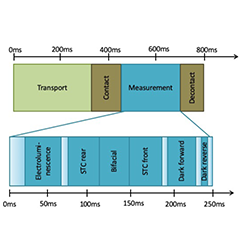Abstract: we analyze available measurement time in a sun simulator in highest-throughput production of silicon solar cells. We explain how this time is distributed on the different measurements, which need to be performed to characterize a solar cell. For high-efficiency solar cells, we elaborate how it is possible to reduce the required measurement time to determine their IV characteristics such that throughput requirements can be met in all cases.
We find that a combination of voltage sweep speed adaptation and advanced hysteresis evaluation is suited for highest throughput without compromising measurement accuracy even for highest-capacitance heterojunction (HJ) cells.
Introduction
Modern solar cell production lines run at high throughput with cycle times of 1 s or below. For the near future, cycle times as low as
800 ms, translating to a throughput of up to 4500 wafers/hour, have to be achieved on a single line of a solar cell tester and sorter.
To allow such short cycle times, handling and measurement times need to meet strict requirements.
At the same time, Si-solar cell efficiency is constantly improving, thereby increasing cell capacity due to higher effective charge carrier lifetime. As a result, the required time for a device to achieve quasi-steady-state conditions after a change in operating conditions, a prerequisite for accurate power rating of solar cells, increases. During IV measurements, the applied voltage is varied from 0 V to open-circuit conditions and beyond, i.e. the operating conditions are modified drastically.






























